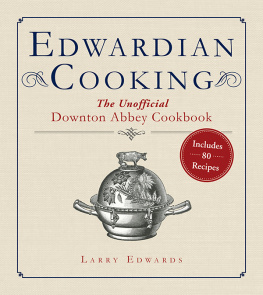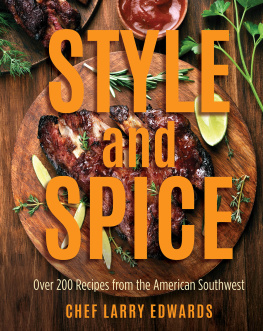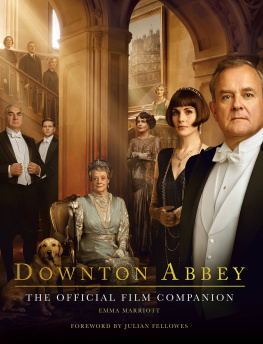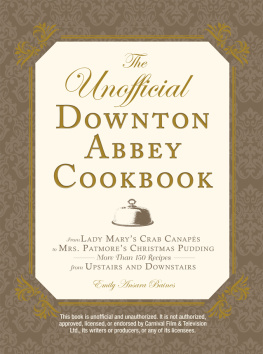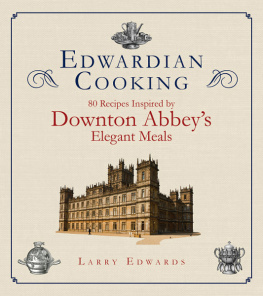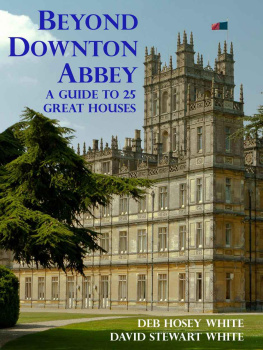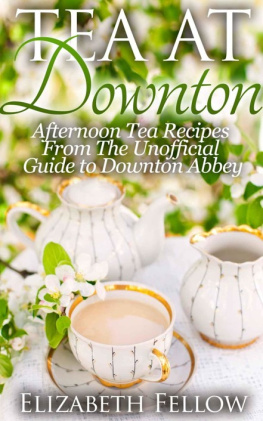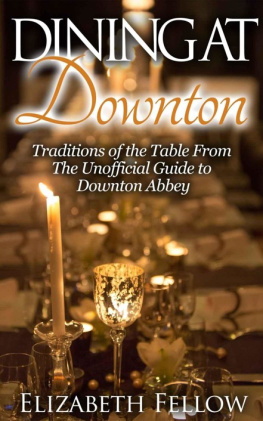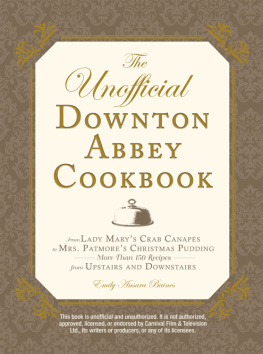
80 Recipes Inspired by
Downton Abbeys Elegant Meals
Larry Edwards

ARCADE PUBLISHING NEW YORK
Copyright 2012 by Larry Edwards
All Rights Reserved. No part of this book may be reproduced in any manner without the express written consent of the publisher, except in the case of brief excerpts in critical reviews or articles. All inquiries should be addressed to Arcade Publishing, 307 West 36th Street, 11th Floor, New York, NY 10018.
Arcade Publishing books may be purchased in bulk at special discounts for sales promotion, corporate gifts, fund-raising, or educational purposes. Special editions can also be created to specifications. For details, contact the Special Sales Departm]ent, Arcade Publishing, 307 West 36th Street, 11th Floor, New York, NY 10018 or arcade@skyhorsepublishing.com.
Arcade Publishing is a registered trademark of Skyhorse Publishing, Inc., a Delaware corporation.
Visit our website at www.arcadepub.com.
10 9 8 7 6 5 4 3 2 1
Library of Congress Cataloging-in-Publication Data
Edwards, Larry, 1957-author.
Edwardian cooking : inspired by Downton Abbeys elegant meals / Larry Edwards.
pages cm
ISBN 978-1-61145-778-0 (hardcover : alk. paper) 1. Cooking, English. 2. CookingEngland. I. Title.
eISBN 978-1-61145-859-6
TX717.E4545 2012
641.5942dc23
2012025191
Printed in China


L ong before there was the rage of organic food, sustained living, and natural eating, there were the abbeys of Great Britain. Though Downton Abbey is a fictitious abbey, what we see dramatized is very real. From the upstairs/downstairs lifestyles, the separation of classes, and the positions of the people, it is all real. Also very real in the television dramatization is the food.
As opposed to Hollywood versions of the late Victorian era and the Edwardian era, opulence was not the center factor of the dining room. There were never large tables groaning with the weight of culinary fare. As fans of Downton Abbey will note, the tables are pretty bare. As a matter of fact, there is never any food on the tables. The food is presented by the footmen to each guest. You never see a golden suckling pig in the middle of a table. You never see large roasts of beef or lamb. You see the table, the linens, the silverware, the service ware, and the glasses.
For the most part, all the food served at the abbeys came from the grounds of the abbeys. On the average, each abbey employed 15 gardeners. These gardeners looked after the vegetable gardens, the fruit orchards, the grazing areas for the animals, and the ponds. All fruit and vegetables were picked the morning before they were prepared. As for the ponds, they were the home to the fish served at the abbey. With very few exceptions, everything served at the abbey was grown at the abbey.
So, what was a typical dinner at the abbey? For the most part, each dinner consisted of three courses. This was elevated to five courses if the guest list featured a member of royalty. The food was prepared by the abbey cook. The cook was assisted by a vegetable maid (who prepped the produce), a stillroom maid (who did the baking), and a scullery maid (responsible for the cookware and bakeware). Other members of the maid staff would plate the food for the footmen to present in the dining room.
Everything that left the kitchen and headed into the dining room was prepared from scratch. The abbey cook would start his/her day at 6 am. The other kitchen staff members would start at 7 am. In the course of their 18-hour day, they would prepare eight meals (this includes the meals for the abbey staff). Along with these eight meals, they would also prepare the food for the various High Teas and the numerous social gatherings whether on the grounds of the abbey or in the various sitting rooms.
In preparing and presenting the dishes included within this book, we wanted to be as authentic as possible. During the late-Victorian era and the Edwardian era, the kitchens were run on wood stoves and ovens. Rather obviously, todays kitchens do not have such appliances, so we have adapted the dishes for todays kitchens. As far as the products used in the presented dishes, with very few exceptions, everything is the same.
During the time-span of this book, Europe was engulfed in the horrors of World War I. Due to this, the culinary fare of Great Britain was undergoing a great change and you will notice this in some of the dishes presented. For the first time the national cuisine was being fused with the culinary fare of France and Italy and the reason for this is quite simple. To escape the horrors of the war, many French and Italian citizens were migrating to England. Many of these people were employed by the abbeys as their usual staffs were being drafted or volunteering for the British war efforts.
In keeping with authenticity, we will be presenting the dishes in this book in the same way the dishes would be presented at an abbey. The first section will be dishes served at High Teaa social gathering featuring more appetizer-type dishes. This section will be separated into sweet and savory.
The section entitled Dinner at the Abbey will be presented just as they were by the footmen serving the guests. You will have the Breads of the Abbey, Soups of the Abbey, and then the side dishes and the entres.
As with any meal prepared and served at the abbeys, dinner will be followed by the Desserts of the Abbey. The desserts served at the abbey were usually very simple and mostly very rich. They were meant to end the evening on a sweet note, not weigh the guests down.
Celebrate the magic and majesty of the food inspired by Downton Abbey and enjoy the royal fare from Edwardian England!


ENGLISH RUM BALLS
(serving amount depends on size)
Like any other home, the abbey had a kitchen budget. The cook was always alert to being frugal. These cookies are a result of being frugal. The base of the confection is day-old shortbread. At Downton Abbey, the perfect day-old shortbread to be used would be the King Edward Coronation Toffee Shortbread (see the recipe in this section). They can also be prepared using commercially produced shortbread, however the richness and taste will be altered.
To many, this confection may look reminiscent to the holiday American cookie known as Bourbon Balls. The difference here, aside from the liquor used, is that this Edwardian version is much more suited to the palate. It has a lighter density due to the use of the shortbread and the sweetness is slightly abated due to the use of powdered sugar.
Once these are prepared, they should be stored in an airtight container and dusted with granulated sugar daily. At the abbey, these would be served a week after they had been prepared (they do not go bad due to the amount of rum used).
| Ingredients needed to make English Rum Balls: |
| 2 cups crushed day-old shortbread cookies |
Next page
